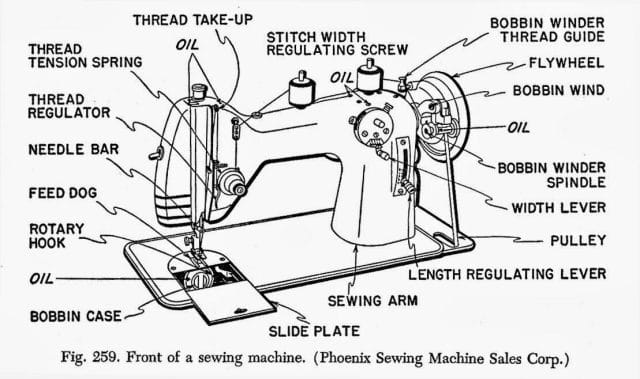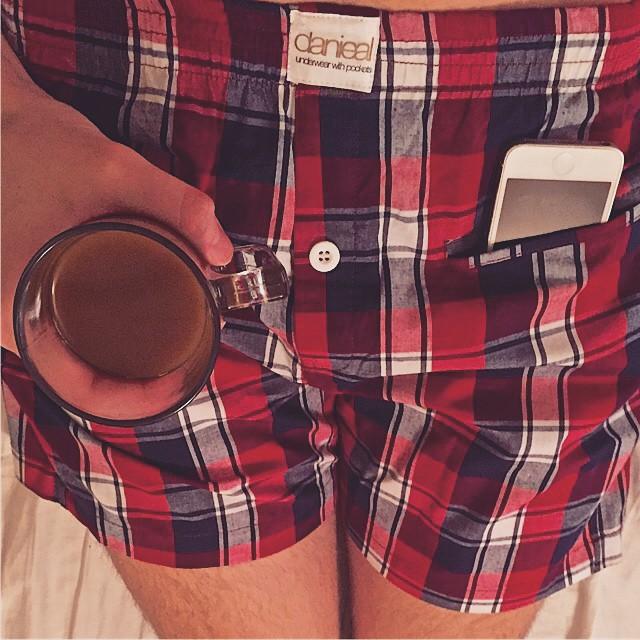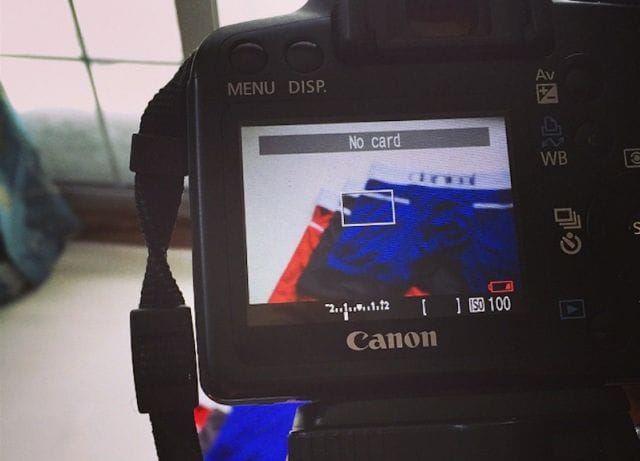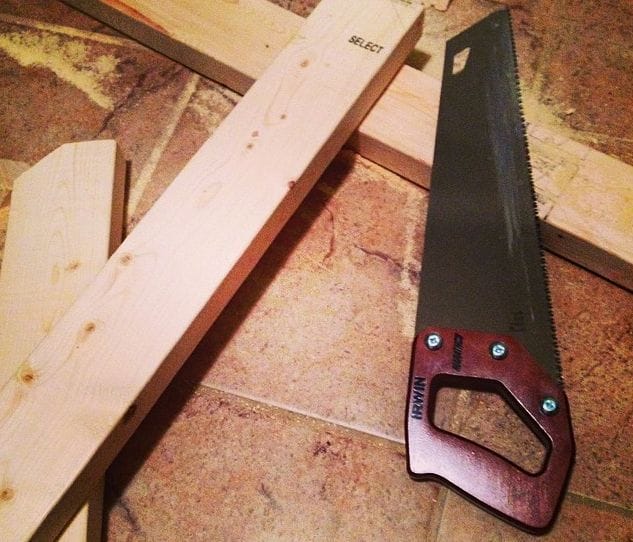

The idea struck on a hot Saturday morning in April.
Twenty-one year old Danieal Cormier woke up late in his apartment in New Brunswick, Canada, rose from bed and walked groggily to the kitchen to brew his coffee — all the while in his underwear (“Everyone does it,” he tells us defensively). Then, as most weekend mornings go, he haphazardly began watching television, cleaning, and “just walking around from room to room.”
While wandering, he’d hear his phone buzz and scramble to find it; every five minutes, he’d lose track of where it was. “Friends were texting me, I was doing e-mails, Facebook, and whatnot,” Danieal recalls, “and I kept doing a hand motion to put the phone in my pocket — a pocket that wasn’t there! Eventually, I realized, ‘Okay, I need a freakin’ pocket.’”
Danieal acquiesced and put on a pair of gym shorts with pockets, so he could carry his phone around the house. But after tasting the glorious freedom of walking around in his underwear, the now-clothed Canadian simply wasn’t satisfied. “I said, ‘Wait — I shouldn’t have to put on a pair of shorts to have a pocket,” he recalls. “That’s just ridiculous.”
“Then it hit me: underwear with pockets.”

At the time, twenty-one year old Danieal Cormier was living a quiet existence. Every morning, he’d schlep to his 9-to-5 job as a sales and marketing assistant at a local hotel chain. Every evening, he’d read, or watch television.
For years, he’d enviously watched his father, the owner and founder of a tile importing business, set his own schedule and make his own decisions. “I’d dream of starting my own business — of having my dad’s autonomy,” Danieal recalls. “I just had no idea what kind of business I’d start.”
On this hot Saturday morning, his dream came true.
In the fervor of his revelation, Danieal went online to “buy a pair of underwear with pockets.” Surely, he told himself, they must already exist. But the market for knickers with compartments wasn’t stellar:
“There were only a few, and the selection sucked. One had these tiny little condom pockets. There was another, but the pockets were inside the underwear. So to access whatever was inside of it, you had to literally slip your hand into your crotch. That’s not exactly what I wanted.”
“Right then and there, I just decided to make my own from scratch,” he says.
There was one problem: Danieal had never sewn a stitch in his life or designed anything remotely resembling a product. But that wasn’t going to stop him. He put on pants, then went out and bought fabric and a sewing machine.

“Never use a sewing machine,” he cautions. “That thing was impossible to figure out. It would jam all the time, the manual was like a dictionary — just the simplest task of loading thread was incredibly difficult for a newbie.” He started slow. Over several “agonizing” weeks, he taught himself how to sew a straight stitch line by pouring over free content on YouTube, Vimeo, and Wikipedia.
The first pair looked like hell.
“I still couldn’t really hem properly,” he says. “The outside looked passable, but the inside looked like…well, the quality just wasn’t there, to put it nicely.” At that point, it didn’t much matter: his goal was just to make himself a pair or two. He was his only critic.
But as he continued to sew new pairs — each increasingly better than the last — he figured, “Why not sell them?”
***
Etsy, an online marketplace where artisans sell handmade goods, can be overwhelming. The site boasts 30 million users (both buyers and sellers) and some 7 million products. It’s a vast sea of (mostly) awesome stuff made by (mostly) talented people. When Danieal joined, he felt like an aimless buoy.
“How could I make this semi-weird looking pair of underwear with pockets stand out? That was the question,” he recalls. “I really figured I wouldn’t make a single sale, or track any interest at all.”
For the thrill of it, he posted his first product: a little red-and-white checkered pair with dual pockets. By enlisting his only marketing tool — a modest knowledge of SEO (or, how to optimize a site to garner traffic from search engines) — he generated somewhat favorable results for his shop in an Etsy search for “underwear with pockets.”
When a week went by with no sales, Danieal began to question his new venture. Then, on day seven, a miracle: his pair of pocketed underwear sold.
Over the next few months, “a dozen or so” more orders came in. “I was still working 9-to-5,” Danieal reminds us, “so balancing work and underwear wasn’t easy.” It took him nearly two hours to put together and sew a single pair — an enormous commitment for a $20 product. A few previous customers had also registered complaints about the underwear’s stitching and sub-par comfort.
So Danieal, on a mission to deliver a high-quality product to his new customers, began to contemplate alternative methods of production. “I looked into sewing lessons so I could do it faster,” he says. “I looked into Canadian seamstresses and factories. I really tried to find a local way to do this in a cost-effective way.”
Eventually he decided that he’d have to take a different route to keep prices low: underwear with pockets was India-bound.

Finding an overseas supplier that met Danieal’s criteria proved to be incredibly difficult.
Not only did he have “very high quality standards” for stitching and material, but he only wanted to produce an initial run of 100 pairs. “Most of them wanted to print 12,000 pairs,” he says. “I was like, there’s no way I’m making 12,000 pairs of pocketed underwear with like ten customers.”
After searching through manufacturing websites for months, Danieal found a few people willing to produce smaller quantities. He narrowed the pool down to ten, then spent weeks calling them, getting samples, and asking “hundreds of questions.”
“I wanted to see the quality, feel it, make sure it was what I wanted,” he says. “Finally, I found a guy whose price was right, and who agreed to do 100 pairs.”
Since Danieal had, until this moment, done everything himself, he struggled with the idea of putting his “baby” in someone else’s hands. But as he interacted with his contact in India, he came to terms with the prospect of enlisting a helping hand. “He was reliable and he was always there when I needed him,” says Danieal. “I’m super lucky I found him.”
The first 100 pairs came with a modest price tag of $550, or $5.50 per pair. The low price was a stroke of luck; Danieal had, after all, elected to fund his underwear company out of pocket.
***
Fully stocked with 100 pairs by the end of March of 2013, Danieal made another crucial business decision: he abandoned Etsy.
“When I saw the new undies, I decided that I wanted to be a brand — not just an independent artisan,” he recalls. “I took everything off Etsy, and started to build my own website, my own company.”
It was another intense process. Danieal, who had very minimal website building experience, programming knowledge, or design work under his belt, decided to do it without hired help. “Ever since I was a kid, I was on the computer fooling around,” he says. “So instead of paying someone thousands of dollars to design a site, I just did it myself.”
Behind the website’s bells and whistles, Danieal also had a strategy: fake it ‘til you make it. He presented his company, Danieal, as a large, established brand in the hopes of tricking people into believing it actually was one. “I set up the site to make it look like it was this official brand — and it turned into one because of that,” he says.

Danieal takes all of his own professional product shots
In May of 2014, with no customers, no followers, and no hype, Danieal went live.
Danieal quickly set out to tell the world about his pocketed underwear, starting with his home town. “I called a ton of shops and stores,” he says. “And finally, the local hospital gift shop randomly agreed to carry the underwear.”
It was an unlikely pairing, but with a bit of luck, it worked. One day in April, an executive producer at the CBC, Canada’s biggest news outlet, spotted the underwear while leaving the hospital. The producer noticed it was made locally and contacted Danieal for a television and radio interview.
Then, says Danieal, “things took off like crazy.”
The company’s name spread by word of mouth. A variety of other local shops offered to stock the underwear; soon, it was featured in a half-dozen stores all over Eastern Canada.
Danieal took advantage of the press and staged an “undie run” to benefit the hospital that had taken a chance on his product. More than 200 runners showed up — more than half of whom ran in Danieal underwear — and all proceeds went to charity.
***
Since May of 2014, Danieal’s company has grown significantly. Today, his underwear is sold “coast to coast” in Canada, and is also featured in the front window of a “hipster clothing shop” in Mississippi. Last month, due to high demand, he added a line of pocketed boxer briefs to his collection. To do so, he had to embark on the long journey of finding another manufacturer who could work with the material. “It was almost like starting my company all over again,” he says.
In ten months, Danieal has sold roughly 2,700 pairs of underwear at $23 per pair, and he says online sales continue to rise each month. Since he does almost everything himself, his operating costs are incredibly low.
Danieal pays just $130 per year for website hosting and operation. It’s his sole technology cost: Danieal built the site himself, designed his own logo, and does all the other design work. He does his own accounting, at an estimated expense of $8 per month, and though he outsources his packaging — a minimal cardboard wrapper — to another Canadian company, it only runs him about 45 cents per pair of underwear. He even learned to build his own store displays: two-by-four pieces of wood with “three underwear-filled baskets” hanging down. “I never built a birdhouse in my life,” he says, “but I was somehow able to construct these giant things.”
His biggest expense, running Facebook ads, pays for itself with sales. “We have great conversion rates,” he claims, “and they’ve proven to be extremely effective.”

Danieal builds his own store displays. “Anything I can do to save money,” he says, “I do.”
As more people purchase Danieal’s underwear, he is increasingly exposed to the (sometimes unintended) impact his products have on people.
“One customer emailed and said he likes my underwear because he can wear his insulin pump at night,” says Danieal. “I never even considered it could have medical applications.”
Another woman wrote to tell Danieal that her husband had just returned from a trip to Paris and had worn the underwear the entire time to avoid crafty European pickpockets. “Travel” is now included as one of the merits of the product on its webpage.
Looking back on his success so far, he’s humbled.
“When I ordered those first 100 pairs of underwear, I thought I’d have them for the rest of my life,” he laughs. “I never thought I would sell them — let alone this many pairs.”
He’s also become something of a local celebrity.
“People will stop me in the mall sometimes and say, ‘Hey are you the underwear guy? I’m a proud Danieal underwear wearer!’” Danieal sheepishly admits. “I guess we have a lot of enthusiastic wearers of underwear in Canada.”

This post was written by Zachary Crockett. You can follow him on Twitter here.
To get occasional notifications when we write blog posts, please sign up for our email list.



